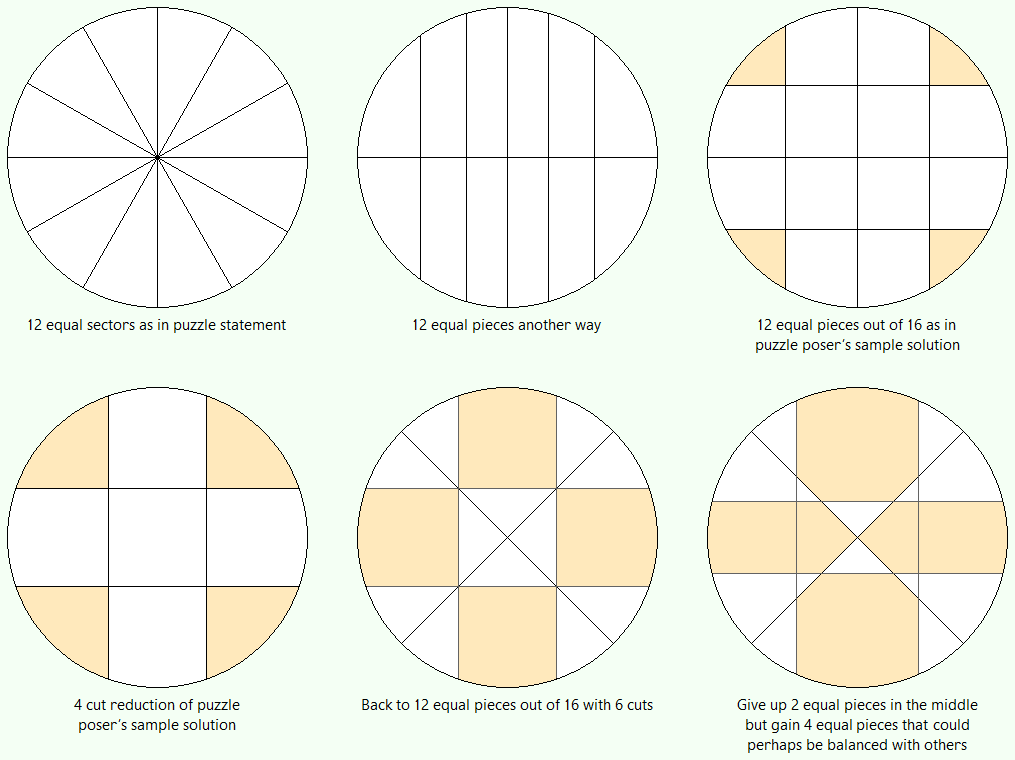☆ Revised
to introduce a general solution of limited value,
to include a solution for 7 cuts,
and to acknowledge a better 6-cut solution
☆
What about $n$ cuts?
Hats off to
Paul Panzer’s tasty
general solution,
which produces more equally sized pieces than
puzzle poser Joe Z.’s general
sample solution
for
$n = 6k > 6$ cuts.
The parabolic result-curves of both those general solutions, however,
begin slower than a linearly growing general solution that produces
$4(n{-}3)$ equally sized pieces from
$n = 2k \ge 6$ cuts.
This linearly growing general solution is an improvement
only in the narrow domain of
$6 \,{<}\, n \,{<}\, 12$ cuts.

None of the general solutions so far cover the case of
$n \,{=}\, 7$ cuts.
Here is a solution with rectangular symmetry
whose number of equal pieces can easily be matched by
Paul Panzer’s specific
solution for 6 cuts
merely by slicing a single segment of pizza
along an appropriately measured chord.

7 cuts, 16 equally sized pieces
Triangles E through L are congruent with
area a b / 2.
Suitably adjusted values for a and b
can make the areas of pieces A and B
also a b / 2,
and thus of pieces C, D, M, N, O and P as well.
This is because increasing the value of a decreases the sum of areas A+B
while increasing the value of b increases the ratio of areas B/A.
Original post follows (slightly edited),
which led to the solutions above.
For 6 cuts, what is the largest number of pieces of equal size
I can obtain (using only straight cuts that go through the entire pizza)?
This is not the most possible with
$n \,{=}\, 6$ cuts
but here are 14 equally sized pieces, A through N,
out of 20 total pieces.
This has 1 equal piece fewer than
Paul Panzer’s beautiful
3-fold symmetric solution
and 2 equal pieces more than both the
$2n \,{=}\, 12$
“naively” sliced sectors of the puzzle statement
and the
$ \displaystyle \raise1ex\strut
\small \big( {\raise-.4ex n \over 2} \kern.05em{-}\kern.1em 1 \big)
\!\!\; \raise1.8ex{\scriptsize 2}
\normalsize \! + 8 = 12 $
equal pieces produced by the general algorithm in
puzzle poser Joe Z.’s
sample solution.

The dimensions shown for triangles E and G
clearly make both of their areas a b,
and thus of pieces F, H, I and J as well.
Suitably adjusted values for a and b
can make the areas of pieces A and B also a b,
and thus of pieces C, D, K, L, M and N as well.
This is because increasing the value of a decreases the sum of areas A+B
while increasing the value of b increases the ratio of areas B/A.
A series of experiments led to the above dissection . . .

. . . along with some later experiments.










